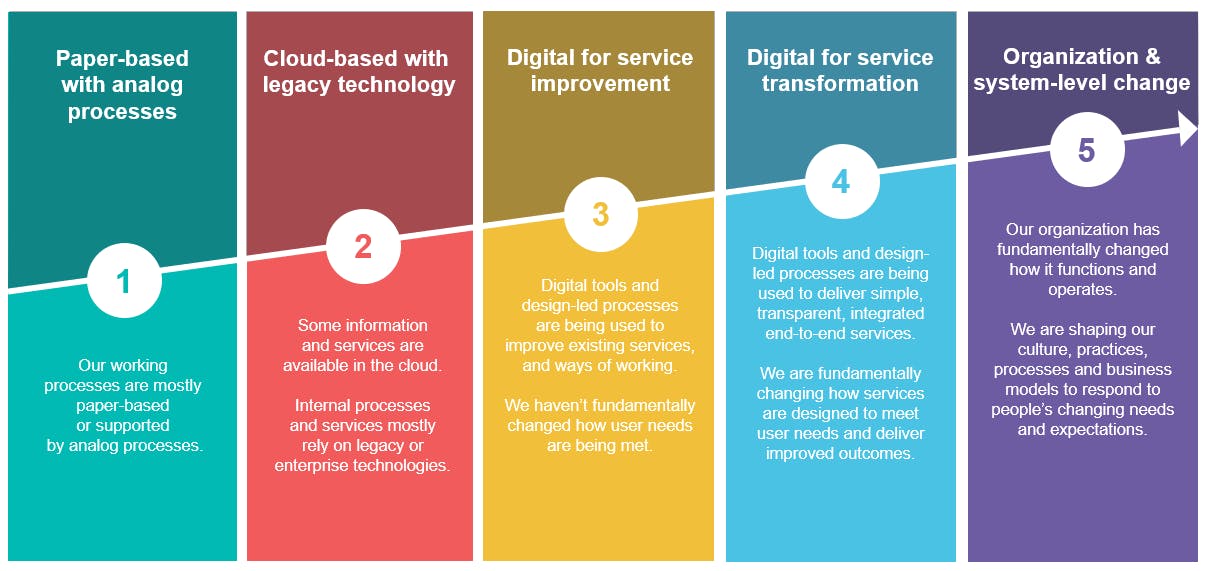
Making the case for digital transformation
In order to thrive in today's landscape, your organization needs to adapt to the constantly accelerating pace of change. Digital transformation is critical to preparing yourself for what's next, but digital transformation goes beyond just implementing new tools and technology. By conducting a financial assessment, creating a business case and building a road map, your organization can make the financial case for your digital transformation.
Recent economic environment
While the U.S. economy has endured ups and downs over the last two years, the broader 10-year picture shows a positive upward trend. Apart from the pandemic, the last decade-plus has featured steady growth for U.S. companies and the market. The trendline since 2010 displays an overwhelming positive climb that has allowed technological progress to flourish.
A 2019 technology study by Accenture examined the correlation between revenues of technology leaders and technology laggards to find that technology leaders (the top 10%) had approximately two times the revenue growth of technology laggards (the bottom 25%).
A similar survey in 2021 concluded that technology leaders had approximately five times the revenue growth of the laggards displaying the rising importance of adopting technology in the post-pandemic economic climate. The time to start your digital transformation is now.
What does this mean for you?
Simply put, digital transformation is no longer something you might want to do, but something you need to do, in order to survive and thrive in today’s current environment.
The cost of inaction is significant. Nokia, for example, used to be a global leader in mobile phones. Due to their focus on hardware over software, within a few years, they were on the verge of extinction. Nokia did not prioritize adapting to the technological needs of its customers and suffered greatly because of it.
From an organizational standpoint, the first question to ask yourself is: Where are we today?
As you can see from the maturity model below, your organization will likely fall somewhere on a 1-to-5 scale – with one being a company that exists mostly on paper and five being a company using technology to create fundamental change in your operations and functionality. No matter where your organization is today in this maturity model, identifying where you are is immensely important in order to get to where you want to be.
How do you get started?
To simplify the process of getting started on your digital transformation journey, we recommend breaking it down into the following five steps.
- Conduct a process maturity and technology assessment.
- Identify gaps in capabilities against best practices
- Assess potential options to achieve goals.
- Prioritize opportunities to enhance capabilities based on effort, value and strategy.
- Build an actionable road map that defines your journey over time.
As part of the process maturity & technology assessment, you need to focus on understanding your organization’s priorities in the following four key areas, as they are heavily impacted by digital transformation.
- Customer: Digital transformation can have a clear impact on your customers’ experience and satisfaction. Digital tools can enable a seamless customer experience and empower the customer at every step of the journey.
- Product: Digital transformation can increase your product value through innovation and enhancement. Sometimes, altering the way you deliver your product digitally can reinvent your organizations value chain.
- People: Digital transformation can enhance the employee experience, empower employee mobility & flexible work, and provide the tools necessary to drive value for your customers and for the business.
- Operations: Digital transformation can automate and streamline your business operations through robotics, AI and ML, enabling the optimization of facilities and services based on real-time data. This can reduce risk while increasing efficiency and accuracy throughout the entire organization.
Although we regard all four impact areas as extremely important, the “customer” tends to take priority. However, in today’s market, the people in your organization should be prioritized as well. Modern workers are looking for technology to better enable them to execute their day-to-day activities.
Why should your organization invest in digital transformation?
Speaking generally, we see three main areas of benefit when it comes to making the case for digital transformation:
- Cost reduction
- Increased revenue
- Risk avoidance
The reality is, there’s almost never just one benefit to digital transformation as it’s a constant rotation of all three.
Developing your digital transformation road map
Perhaps the most important step in this process is developing a road map that lays out why, what, how and when you are going to execute your digital transformation strategy. The road map should be considered a living, breathing document that needs to be reviewed and updated on a regular basis. Technology changes constantly. Business changes constantly. Your organization and its road map need to be open to change as well.

The importance of change management
Digital transformation initiatives are only as successful as the rate at which people and the organization adopt and embrace change. Successful change occurs when you clearly communicate the changes and train the appropriate individuals within the organization so the change is sustainable and impactful. From a people standpoint, it is important to understand all the change management considerations– both benefits and risks.
With that in mind, we want to stress that digital transformation endeavors are not IT projects. They need to be owned by the business and, at its core, all the people that make up the business. IT resources are a key component, but the business needs to take a collective ownership of the transformation process.
The benefits are clear when it comes to change management, including:
- Reduce risk of not delivering on original objectives
- Reduce risk associated with transitioning people to new processes and systems
- Clearly defines and communicates new job roles, responsibilities and behaviors
- Increases knowledge transfer and reduces re-training
- Prepares organization to operate in the new environment and increases success rate and speed of adoption
So, what are the keys to success?
Digital transformation is a journey, not just something that will happen overnight, which is why it is more important than ever to act. When making the case for digital transformation, it’s important to remember:
- Start with your future state vision as your guiding star and work backwards to the technology
- Successful transformations are more than just technology and data – they are as much about people, processes and governance as purely technical aspects.
- Utilizing proven change management methodologies are key to better enabling the organization to realize the full value of digital transformation.
Contact us to learn more about how we can help you get started on your digital transformation journey to accelerate sustainable growth.


